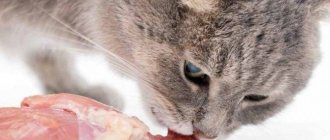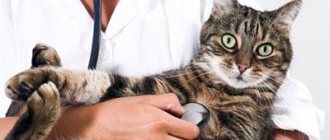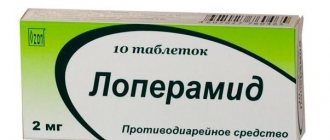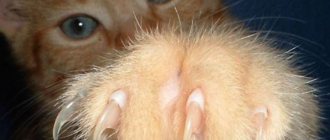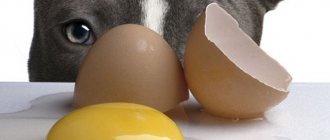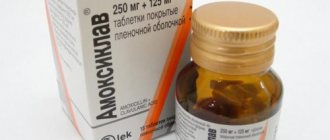Cats are very picky eaters. But even though they turn their nose up at the expensive food bought by the owner, sometimes even the most fastidious animal can get poisoned. Because of its curiosity, a pet can swallow something from toxic household chemicals and, for example, poison for rodents. In most cases, the animal will require emergency assistance, which, by the way, the owner is able to provide on his own. Adsorbents are good remedies for relieving the symptoms of poisoning, but not all pet owners know whether regular activated carbon will help their cat.
- Master, maybe it’s better than fish?!
Poisoning in cats
Having decided to get a cat, the owner must understand that feeding, cleaning the animal’s litter box and combing it regularly is only half the battle. If you have a four-legged friend in the house, it is very important to ensure his complete safety. This is especially true for small kittens, who strive to taste something. And this is not necessarily due to the fact that the owner does not feed his pet enough. Most likely, teething or a weakened sense of smell is to blame. Therefore, food that is not at all intended for a weak and fragile body often ends up in the stomach of little fidgets. Hence, gastric and intestinal disorders in the form of diarrhea, vomiting and other signs of intoxication.
Poisoning in a cat
It is worth noting that 10% of all cases of visits to veterinary clinics are due to poisoning of pets, which is associated with hunting qualities and their natural curiosity. This leads to the fact that the cat tastes everything that comes its way: expired products, plants, spoiled food, etc. The pet’s habit of licking fur can also lead to poisoning. As a rule, harmful substances accumulate on it (poorly washed off shampoo, flea drops, parasite decay products, etc.).
Symptoms of poisoning in cats are similar to humans
How can you tell if an animal is poisoned? Here are the main symptoms:
- loose, watery stools, the frequency of which can be from 5 times per day;
- rapid breathing;
- refusal of food;
- dark urine, frequent urination;
- dry nose, dilated pupils;
- a radical change in behavior (an active cat becomes too calm, immobilized, sleeps all the time);
- putrid odor from the animal’s mouth, glow in the dark vomit (observed in case of phosphorus poisoning);
- heavy breathing, production of large amounts of saliva, swelling of the tongue and gums (acid poisoning);
- decreased temperature, ulcerations on the oral mucosa, paralysis, uremia (mercury poisoning);
- regurgitation, vomiting; in severe cases, convulsions, trembling, loss of consciousness, and paleness of the mucous membranes of the mouth are observed (this indicates the onset of dehydration).
If one of these signs is present, you need to sound the alarm. The best option is to contact a veterinarian. If this is not possible, then you urgently need to give your pet “Activated Carbon”. The drug is absolutely harmless to four-legged animals, so veterinarians recommend giving it in case of poisoning - and the sooner the better.
Can diarrhea be treated with charcoal?
Activated carbon binds and evacuates toxins. This is useful for some diseases:
- in case of bacterial infections, fermented products are evacuated (which causes flatulence);
- in case of helminthic infestations, it is useful to remove accumulated mucus and those toxins that the worms secrete;
- but charcoal is most useful for food poisoning.
Please note that in most cases (except for intoxication), activated charcoal does not eliminate the cause of diarrhea, so the drug can only be used as symptomatic therapy.
To eliminate diarrhea itself and its causes, it is necessary to take other means.
In what cases is it prescribed and how does the medicine work?
Once in the stomach, the drug begins to act immediately. The main component of the medicine is charcoal of plant and animal origin, which has undergone special treatment. It has a detoxifying effect, that is, it cleanses the body of waste, toxins and allergens. The action consists in the absorption of liquid containing toxic substances by coal particles.
"Activated carbon" for cats
Veterinarians recommend taking the medicine within 2 hours after poisoning. The fact is that during intoxication, the mucous membranes of the gastrointestinal tract work in enhanced mode. This leads to increased mucus production. In such an environment, bacterial flora multiply faster. Therefore, in this case you cannot hesitate. The body expends too much energy and fluid, which contributes to dehydration.
And if against this background the pet is also fed, then injury to the walls of the stomach and intestines is added to the ongoing process. Due to swollen mucous membranes and a lack of beneficial bacteria, nutrients are not absorbed and food is not processed.
The sorbent acts like a sponge that absorbs harmful components. Coal is not absorbed into the blood and is excreted from the body in feces in its original form. The drug does not affect digestion and peristalsis.
Pore structure of “Activated carbon”
In addition, the medicine has an antimicrobial effect. It adsorbs and removes bacteria from the intestines, which helps the body cope with the infection faster.
Activated carbon will help if you take it as soon as possible after consuming poisoned food. If harmful substances are absorbed into the blood, the drug will not have a therapeutic effect.
The owner’s task during intoxication is not to give food, give more water and not influence diarrhea and vomiting. It should be remembered that diarrhea and vomiting are natural processes that rid the body of harmful substances, so they cannot be prevented.
Dehydration is very dangerous for cats
Important! The owner should be wary if the cat experiences diarrhea and vomiting more than 5-6 times a day. This is fraught with the development of dehydration due to significant loss of water by the body.
Indications for the use of charcoal for cats:
- fermentation and rotting in the intestinal cavity, flatulence;
- increased acidity of digestive juice;
- diarrhea, vomiting, blood in feces;
- allergy;
- poisoning with chemicals, drugs, juices of indoor plants;
- salmonellosis, dysentery;
- vomiting and diarrhea after taking anti-worm medications;
- liver diseases.
Preparations similar to Activated Carbon
What else do you need to know
- It is necessary to find out what exactly the cat was poisoned with: it depends on how exactly it will be treated.
- Charcoal absorbs everything, even medicine. Therefore, it should be given separately from other prescribed drugs.
- You cannot delay your visit to the clinic. Improvement in well-being may be temporary, because when poisoning occurs, not only the intestines suffer. The greatest impact falls on the liver, which removes toxins from the blood. This requires an individually selected treatment regimen and diet, which can only be prescribed by a veterinarian.
- If the doctor has warned you about the dangers of taking activated carbon, it is better not to treat the animal yourself.
- If the poisoning is severe, the charcoal may be useless. The veterinarian can prescribe injections and droppers with special solutions that will do the job perfectly.
We suggest you read: Who does the cockerel fish get along with?
How to give the drug to animals?
Almost all cats resist when the owner tries to give him a pill. Of course, because their unusual taste is far from their favorite food. This will require some skill. Here are the step by step steps.
- Place the pet on your lap so that its hind legs rest on the owner's stomach.
- Use your left hand to lift the animal's head. Pull your lower lip towards the back of your head. In cats, after 4 lower and 6 upper premolars, there are no further teeth. This makes it easier to administer the medication into the mouth. By pulling the lower lip back, at the root of the cat's tongue you can see a hollow hole into which a syringe fits perfectly.
- You cannot lower the animal’s head down or remove your hand until he swallows. To stimulate the swallowing movement, you need to stroke it along the neck.
It is important to properly restrain the cat before giving the drug.
If the owner is afraid of being scratched, then you can ask other family members for help or simply wrap the animal in a blanket or towel so that if the opportunity arises, he will not let go of his claws.
The whole tablet can be given to the cat. You need to press your fingers on the area between the upper and lower lips. In this case, the animal’s head should be raised. When the pet's mouth opens, a tablet is placed on the root of the tongue. Then the jaws close. You cannot remove your hands until the animal makes a swallowing movement.
Video - How to give pills to cats?
After swallowing the tablet, the cat must be given water. He must drink at least 1 glass per day. In order for the drug to help your pet, you should know what dosage is acceptable for it.
Features of the treatment of small kittens
When an animal has diarrhea, charcoal does not distinguish between harmful and beneficial substances. If the kitten is given any other medications, then charcoal may reduce their effectiveness, so it is better to give it to your pet an hour after taking the other medications.
The drug has a positive effect on the intestines, so it is allowed to be used even when the pet is severely weakened.
Coal will eliminate symptoms of intoxication in case of mild food poisoning or during a diet change.
Dosage
It would be good to give the cat the whole tablet. But, since this is problematic in most cases, a crushed tablet mixed with water is also suitable for medicinal purposes. The resulting mixture can be given using a small spoon or syringe, after removing the needle. A small sterile syringe will also work in this case.
How to give activated carbon correctly
The dosage of the medicine is calculated depending on the weight of the cat. So, per 1 kg of her body weight, 0.25 g of active substance (1 tablet) is recommended. The drug should be given to the four-legged animal every 4 hours, but no more than 4 times a day.
For a kitten whose age does not exceed 1-2 months, half a tablet is enough; from 2 to 6 months you can give the whole tablet at one time.
Such a kitten should be given half a tablet of Activated Charcoal.
It is worth saying that intoxication symptoms, as a rule, are noted after 1-2 hours. During this time, poisons and toxins have time to be absorbed into the walls of the stomach and intestines. If the animal does not have time to take black coal within this period of time, then this threatens the penetration of harmful substances into the blood.
There is no point in inducing vomiting after 2 hours - it will only torment the cat. In this case, you can give a cleansing enema based on black coal. To do this, 10-15 g of powder is added to a glass with 100 ml of warm boiled water. After the procedure is completed, the cat must be given charcoal orally.
When coal won't help
Painkillers for cats: which ones can you give?
Activated carbon is ineffective in treating poisoning by the following substances:
- inorganic toxins: ammonia, borates and borax, bromide, fluoride, chlorates, cyanide, iodide, nitrates and nitrites, phosphorus, sodium chloride;
- heavy metals: arsenic, copper, iron, lead, lithium;
- caustic acids and alkalis, cationic detergents, paraquat and diquat;
- petroleum products: kerosene, xylene;
- substances with small polar molecules: alcohols, ethylene glycol, urea.
Overdose of “Activated Carbon” for cats
You cannot treat cats with Activated Carbon if they:
- stomach bleeding;
- ulcers in the gastrointestinal tract;
- sorbent intolerance.
It is worth noting that prolonged use of the drug and excess dosage threaten problems with stool - constipation. Dry and dense feces can form a plug, leading to intestinal obstruction.
Abuse of sorbents can cause problems with stool in the animal.
Attention! If the animal does not go to the litter box for more than a day, you should consult a veterinarian.
If you uncontrollably feed your four-legged pet charcoal, this will help flush out nutrients, vitamins, and minerals from the body, as well as reduce the production of gastric juice, the main task of which is to break down fats and proteins.
Pet owners should remember that dark gray coloration of feces is a normal reaction after taking Activated Charcoal.
Activated carbon darkens cat feces
As for an overdose, its main symptom is constipation. How can you tell if your cat has problems with bowel movements? Here are the main symptoms of temporary intestinal obstruction:
- the animal strains in the tray, but feces do not come out, and the cat may meow loudly;
- abdominal pain;
- when palpating the pet’s abdomen, a compaction is noted;
- feces are dry and cracked.
To prevent side effects, you should follow the dosage and give the animal water (1 tablet 10 ml).
Activated carbon is safe for pregnant cats
Is it possible to feed Activated Carbon to pregnant or lactating cats?
Veterinarians recommend treating lactating and pregnant cats with the drug. The active substance of the drug is not absorbed by the gastrointestinal walls and does not penetrate into the blood, and therefore does not pose any danger to kittens in the womb.
Important! Activated carbon should not be given to cats for preventive purposes.
Contraindications and side effects
The main contraindications for use are:
- peptic ulcer;
- stomach and intestinal bleeding;
- intolerance to the components of the medication;
- diabetes;
- allergy to starch.
With prolonged use of the medicine, undesirable consequences may develop. These include:
- constipation;
- adsorbs a large amount of vitamin, which leads to vitamin deficiency in the animal;
- leads to a decrease in the acidity of gastric juice.
What an owner should do if a cat is poisoned
To treat poisoning in a cat, you should act quickly and follow a number of recommendations from veterinarians.
At the first symptoms of poisoning, you should consult a veterinarian
- Call the vet.
- A poisoned cat should be taken to a well-lit and ventilated place.
- The owner must wear long sleeves to protect his hands from contact with poisons. After all, cats can show aggression when they are sick – biting and scratching.
- Induce vomiting in the cat. This must be done immediately after the animal eats poisonous food. To do this, you need to give your pet 3% hydrogen peroxide (1 tsp per 1 kg of weight). The portion is divided into several doses. Usually after the second the cat starts vomiting. You can give the animal water with vomit root (in the form of syrup, sold in a pharmacy), or saline solution.
- You should not feed the cat.
- After vomiting, give “Activated carbon” at the rate of 0.25 g per 1 kg of pet’s weight.
- Drink more water.
- If toxic poisons remain on the fur, then it is better to wash the pet so that it does not lick off the remaining toxic substances.
Attention! If the poisoning is severe, then the dosage of the medicine can be increased to 1-4 g per 1 kg of the cat’s weight. The medicine should be given every 4-6 hours for 3-5 days.
A cat can become poisoned by catching a rat that has had contact with the poison.
“Activated carbon” and isoniazid (rat poison) poisoning
Isoniazid is used by dog hunters to bait cats and dogs. If an animal is accidentally poisoned by this substance, you should:
- call the veterinarian;
- induce vomiting immediately;
- feed the animal a laxative (so that the poison does not have time to be absorbed into the digestive tract);
- give “Activated carbon” (before and after vomiting);
- give “Pyridoxine” - vitamin B6 (if animal haters live in the next apartment, it is better to have this drug in the first aid kit);
- give Corvalol - 3 drops per 4 kg of weight;
- solder with water.
Examination by a veterinarian
If you are poisoned by rat poison:
- call the veterinary clinic;
- urgently induce vomiting, give an enema or give a laxative;
- feed “Activated carbon”;
- use an antidote - vitamin K (necessary for blood clotting);
Table. Permitted analogues of “Activated carbon”
| Names of analogues | Main active ingredient | Peculiarities | How to take for cats |
| "Polyphepan" | Lingin hydrolytic and activated carbon | Several hundred times higher than the adsorption capabilities of Activated Carbon. Can be taken for preventive purposes | For diarrhea, 1 teaspoon 30 minutes before meals 3 times a day for 7 days |
| "Enterosgel" | Polymethylsiloxane polyhydrate | Has a large number of contraindications. More successfully removes toxins and allergens from the animal’s body. In case of poisoning, it can help the first time | ½ teaspoon for a kitten, 1 teaspoon for an adult cat. Diluted with water 1:3. Give 2 times a day before meals 2.5 hours or after |
| "Smecta" | Dioctahedral smectite | Eliminates diarrhea and gastrointestinal disorders after the first use. Does not cause side effects. Has no contraindications | ½ teaspoon for a kitten, 1 teaspoon for an adult cat 2 times a day. Diluted with water 1:2 |
| "Polysorb" | Silicon dioxide | 30 times more effective than Activated Carbon. High adsorption characteristics. A large number of indications for use. Relieves the animal from nausea, vomiting, abdominal pain, diarrhea within 4 minutes | Diluted with 20-35 ml of water. The norm is 1 mg per 1 kg of cat weight. Can be given up to 5-6 times a day |
Blister beetle poison and “Activated carbon”
The blister beetle is a kind of assistant to agricultural workers. Its purpose is to destroy plant pests. It has a bright red color. The insect never bites. Its cunning lies in the release of a toxic substance - contharidin. A few hours after the poison enters the mucous membranes of the mouth, in the gastrointestinal tract (when a beetle is bitten or swallowed), ulcers with purulent discharge form on the walls, which leads to the rapid death of the pet.
Blister beetle
If immediately after a cat swallows an insect, you feed it Activated Carbon, then the likelihood that the animal will survive increases.
When treating cat poisoning with Activated Carbon, the dosage should be observed. An incorrect ratio can lead to an overdose and unwanted effects, one of which is severe constipation.
